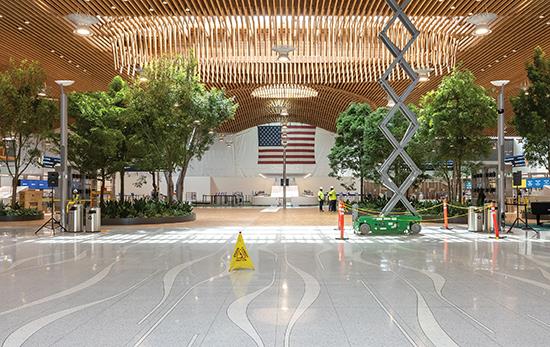Portland Airport Main Terminal: Portland International Airport’s flooring will continue to make memorable impressions on travelers – August/September 2024
By Kemp Harr
In mid-August, Portland International Airport (PDX) opened phase one of a $2.1 billion main-terminal upgrade. This gateway terminal to the city of Portland, Oregon makes a memorable statement to arriving guests with its cathedral wooden ceiling, towering plate-glass walls and classic trio of flooring materials: terrazzo, solution-dyed nylon carpet and solid white oak hardwood.
The Port of Portland has long had a unique vision for its gateway airport. While the area is perhaps best known for its abundance of stunning natural features, including its mountain vistas and rivers, it is also known for its sales-tax-free status, and, as such, the Port of Portland’s original vision was to create a marketplace in the airport, within which visitors could gather, shop and eat at venues with local ties to the area. (This was prior to the post-9/11 security laws that mandate only ticketed passengers beyond the ticket counter.) As a city that prides itself on standing out, the airport was to be a representation of that ideal, with only Oregon-based shops and concessionaires, and pricing was to be consistent with downtown city costs, with the hope of attracting to the airport patrons not even waiting for a plane or a passenger.
CREATING A SENSE OF PLACE
In the new main terminal, terrazzo was specified for the high-traffic zones for its ability to withstand significant and messy foot traffic as visitors enter the building from Portland’s notably wet environment. Within the reception, seating and ticketing areas, 180,000 square feet of J+J’s tufted carpet were used. And 75,000 square feet of locally sourced solid white oak flooring from Zena Forest Products, an Oregon-based, family-owned business, is featured in the corridors and food zones. The EdgeGrain product was developed specifically for this project.
This isn’t the first time PDX has drawn attention with its flooring. In 2015, Floor Focus wrote about the replacement of its iconic woven Axminister carpet that was installed throughout the gate areas in the late ’80s. It was the carpet’s odd teal color, ’80s-esque line-dot graphic, and distinctive location in a passageway leading to home for some and to beloved destinations for others that generated its iconic status; as cellphone selfies grew popular, all a traveler had to do was text an image of their feet on the carpet to communicate, “I’m here.”
After an impressive 28 years of use in that high-traffic environment, the original woven Axminister carpet was replaced with 720,000 square feet of a new tufted carpet by J+J Flooring, featuring an updated color palette and graphic inspired by the original broadloom, and in the nine years since its installation, the new carpet has performed well. However, travelers nostalgic for the original iconic design will find an additional 5,800 square feet of it in various zones and resting areas in the new main terminal.
Terry Green, general manager at Rubenstein’s Contract Carpet, has a 35-year relationship with PDX and its floors. Green studied architecture at the University of Oregon and opened an architectural firm in Eugene, Oregon, which he ran for three years before joining Randy Rubenstein’s business in 1985. Rubenstein’s, a Starnet member organization, installed the airport’s flooring in the mid-’80s and is the preferred contractor for the current main-terminal project.
HISTORY OF THE ORIGINAL CARPET DESIGN
When the Port of Portland was rethinking its airport design in 1986, it hired SRG Partnership as the architect and design firm. Laura Hill, principal interior designer, was 30 when awarded the project and is now retired. According to a recent interview with Hill, “The port’s main goal was to make the airport a welcoming gateway to Oregon and to reflect on the Pacific Northwest.”
The airport’s carpet design, she reports, “was a piece of a much larger project. I must say, of all of my design work in my career, it was not the one I thought would still be so popular, and I just wish I had a nickel for every time that the carpet was reproduced.” Once the design reached iconic status, it was used on hats and socks, on cookies and cakes, on yoga pants, and even on people’s skin as tattoos.
“When they finally started designing the carpet, everyone had ideas,” Hill recalls. “There was a big proponent for roses, rose patterns, because of the Rose City.
“Then the interest moved to mountains and waves. But even that was too specific to Western Oregon. Another idea was clouds and raindrops, which for obvious reasons was rejected.”
Hill reports that the team then started experimenting with geometries that would be more practical for large, open corridors. “Someone said, ‘Gee, that kind of looks like the screens of the control tower where airplanes are Xs and runways are little diamond patterns,’ and that idea took off,” she says, adding, “I don’t mean that as a pun.”
The PDX main terminal ceiling features 2.6 million board feet of Douglas fir across its massive nine-acre expanse. With sustainability an important factor in the PDX renovation, the lumber was sourced from Yakama Forest Products and grown on the ancestral lands of the Coquille Indian Tribe in southwestern Oregon. The tribe prides itself on its selective harvesting process.
Copyright 2024 Floor Focus
Related Topics:Starnet
